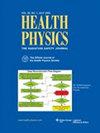用托马斯法和库斯奈兹法测量氡子体浓度时,违反计数统计条件的后果并不严重。
IF 1
4区 医学
Q4 ENVIRONMENTAL SCIENCES
引用次数: 0
摘要
在使用托马斯或库斯耐茨方法分析氡后代样本时,我们违反了计数统计的一个条件,因为我们使用的计数时间与放射性核素的半衰期相比并不短。结果就是,如果我们使用计数统计而不进行修正,我们就会高估计数的不确定性。在这项工作中,我介绍了将理论上的计数方差值调整为更精确值的方法,并计算了在使用计数统计而不进行校正的情况下高估计数不确定度的数值。这些数值小得出奇:托马斯方法为 4-5%,库斯涅茨方法为 2-3%。现在,我可以对氡后代测量的不确定度值进行修正,如果这样做是合适的。我在这里介绍的详细计算方法可用于确定对使用与这里所述不同的取样和/或计数时间测量氡原浓度的方法的计数不确定度的修正。此外,它们还可用于任何需要较长计数时间才能获得大量观测计数的样品,不一定是氡原。本文章由计算机程序翻译,如有差异,请以英文原文为准。
Consequences of Violating Conditions of Counting Statistics Are Not Severe When Measuring Radon Progeny Concentrations with the Thomas and Kusnetz Methods.
When analyzing samples of radon progeny using the Thomas or Kusnetz methods, we violate one of the conditions of counting statistics because we use counting times that are not short compared with the half-lives of the radionuclides. The result is that we overestimate the uncertainties of the counts if we use counting statistics without correction. In this work, I describe the method by which I adjusted the values of variance of the counts theoretically to values that are more accurate and calculated the amounts by which I overestimate the values of counting uncertainty by using counting statistics without correction. These values are surprisingly small: 4-5% for the Thomas method and 2-3% for the Kusnetz method. Now, I can correct uncertainty values of radon progeny measurements if it is appropriate to do so. The detailed calculations I present here may be used for determining corrections to the counting uncertainty for a method for measuring radon progeny concentration using different sampling and/or counting times than those described here. Further, they may be used for any sample, not necessarily radon progeny, that requires a long counting time to acquire a significant number of observed counts.
求助全文
通过发布文献求助,成功后即可免费获取论文全文。
去求助
来源期刊

Health physics
医学-公共卫生、环境卫生与职业卫生
CiteScore
4.20
自引率
0.00%
发文量
324
审稿时长
3-8 weeks
期刊介绍:
Health Physics, first published in 1958, provides the latest research to a wide variety of radiation safety professionals including health physicists, nuclear chemists, medical physicists, and radiation safety officers with interests in nuclear and radiation science. The Journal allows professionals in these and other disciplines in science and engineering to stay on the cutting edge of scientific and technological advances in the field of radiation safety. The Journal publishes original papers, technical notes, articles on advances in practical applications, editorials, and correspondence. Journal articles report on the latest findings in theoretical, practical, and applied disciplines of epidemiology and radiation effects, radiation biology and radiation science, radiation ecology, and related fields.
 求助内容:
求助内容: 应助结果提醒方式:
应助结果提醒方式:


